I never planned for a sunset to define my time in Miami. I came chasing rhythm, color, and the pulse that everyone talks about, expecting to be swept up in noise and nightlife. But as each day ended, the city revealed something quieter, a beauty that asked for stillness instead of motion. One evening by the bay, watching light dissolve into water, I realized that Miami’s truest charm lives in its sunsets. They aren’t just backdrops for photos; they’re the city’s heartbeat, slowing everything down until all that’s left is reflection.
Jump to: Anticipation • Light & Sound • South Pointe • Matheson Hammock • Hobie Beach • The Kampong • Bill Baggs • Sunset Harbour Marina • Science & Feeling • Skyline Aglow • Stillness • Falling in Love • FAQ
TL;DR - Watching a Miami Sunset
- Miami’s humidity and ocean air amplify the colors of dusk.
- Sunset Harbour offers quiet reflection beside rippling Biscayne Bay.
- South Pointe Park blends ocean breeze, skyline views, and solitude.
- Matheson Hammock Park’s lagoon mirrors rose and amber skies.
- Hobie Beach glows with the city’s reflection and gentle waves.
- The Kampong reveals hidden beauty beneath a canopy of trees.
- Bill Baggs Lighthouse turns history and sunset into poetry.
More on Miami:
Anticipation and Arrival
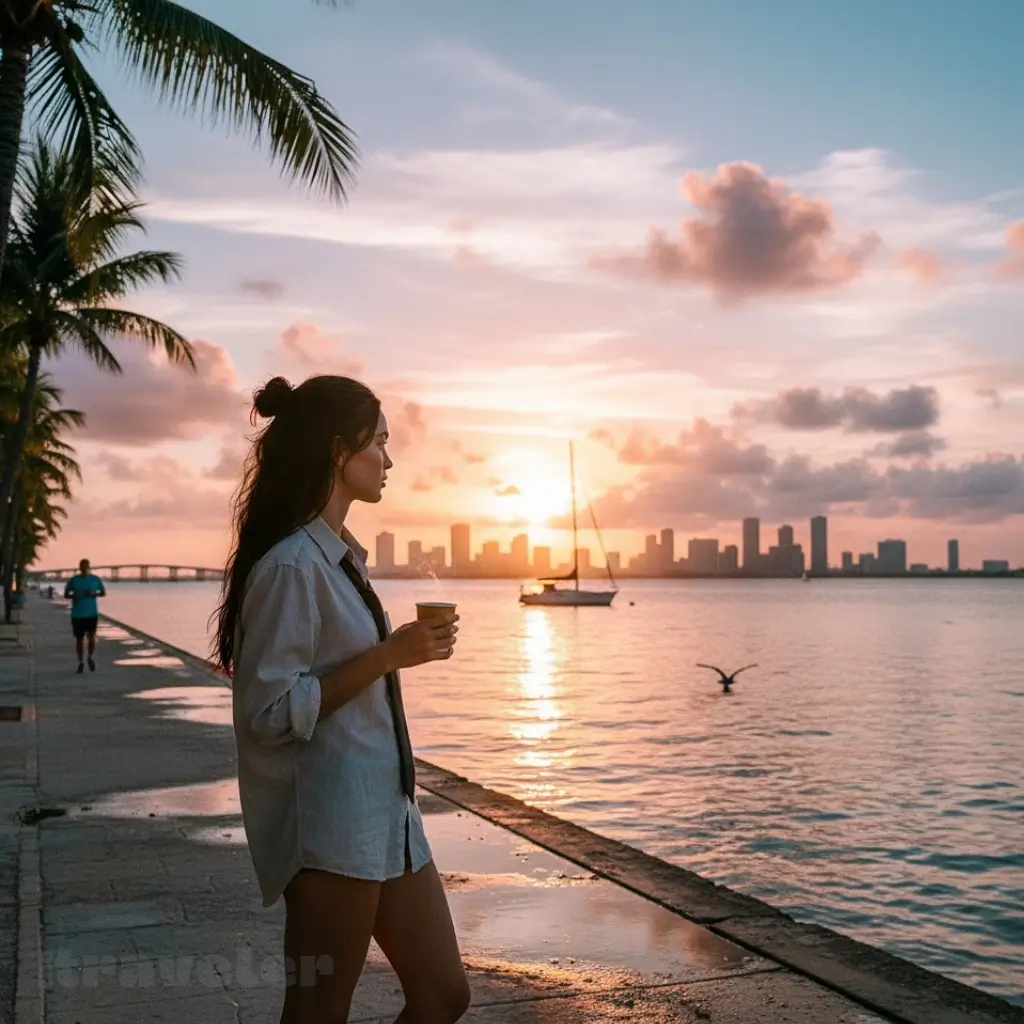
I did not grow up in Miami. My earliest impressions of the city were formed through glossy postcards and television shows where flamingos, neon lights and thumping beats seemed to blur together. By the time I finally booked a ticket south, I carried those stereotypes like extra luggage. I wanted sun‑kissed beaches, art deco buildings and maybe a late night at a salsa club. What I did not expect was that the moment that would make me fall in love with the city would be one of its quietest – watching the sun slip toward the horizon and set Biscayne Bay ablaze with color.
Before that evening, sunsets were something I seldom noticed. In busy northern cities they disappeared behind skyscrapers and were often obscured by clouds or the glow of streetlamps. In Miami, I learned that sunset is a ritual. The people who live here understand its power; they pause, breathe and allow the day’s last light to wash over them. As I made my way to the edge of Biscayne Bay, I felt a sense of anticipation as tangible as the humidity in the air.
The heat pressed against my skin, but the trade winds off the Atlantic carried a whisper of coolness that promised relief. Miami’s tropical climate is responsible for more than the sweat on your brow; it also sets the stage for dazzling evening displays. The humidity and ocean air scatter sunlight so effectively that the hues of sunset appear more brilliant and last longer than in less humid places.
That mixture of salt and moisture is why Miami’s sunsets often explode in shades of orange, pink and purple , and why the reflections off the ocean amplify every tone. Even before the sun touched the horizon, I could sense how different this sky would be compared to the ones I knew.
Light and Sound

I chose a spot in Sunset Harbour, a South Beach neighborhood whose name suggests its purpose. This area sits along the northwest edge of the island, where sailboats are moored and the Venetian Causeway frames the view. As the evening crowd thinned, I claimed a park bench facing west. In front of me the water shimmered, ruffled by gentle ripples. The salty scent mingled with the sweetness of blooming tropical flowers, and nearby palm fronds rustled quietly. In the distance, voices and laughter drifted from restaurants, but the atmosphere remained tranquil. When the sun began its descent, the scene transformed.
The sunset painted the sky in dazzling colors and the hues reflected off Biscayne Bay. It felt like a private show in a city famous for public spectacle – the sky itself performing a slow burn.
At first the light was soft and golden, illuminating the art deco façades behind me and casting long shadows along the waterfront. Tourists snapped photos, joggers slowed to watch and couples paused mid‑conversation. Then orange streaks deepened into apricot, pinks blossomed into rose, and purples emerged at the edges of clouds. My eyes kept flitting from the horizon to the water’s mirror, marveling at how the bay captured the sky’s mood. Miami’s ocean reflection intensifies the colors, making each sunset an unforgettable visual experience. There is science behind this beauty.
As light travels through more atmosphere at sunset, the shorter blue wavelengths scatter out of view, leaving longer wavelengths like yellow, orange and red to dominate. Clouds, floating like loose paint strokes, catch and reflect those longer wavelengths. The result is a spectrum that can feel otherworldly yet grounded by physics.
The Stage at South Pointe
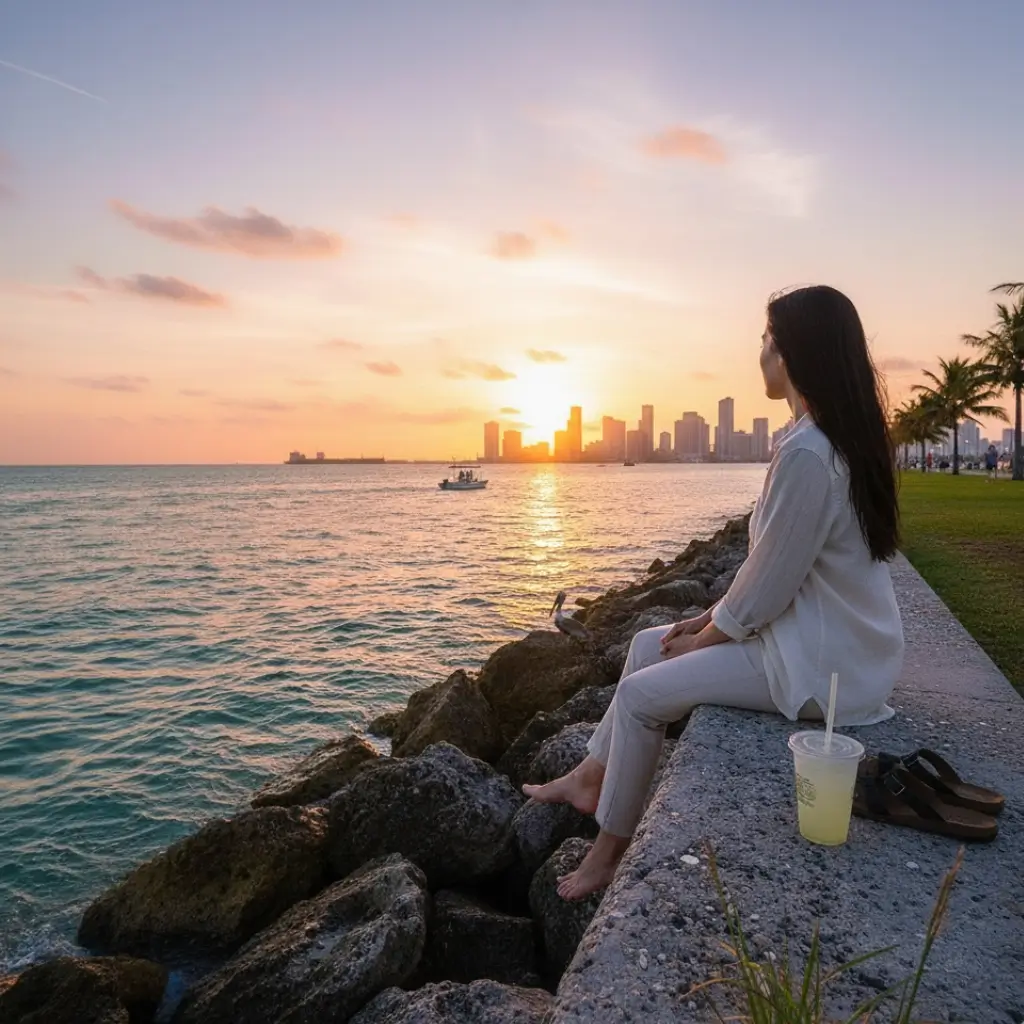
Another evening I made my way to South Pointe Park, the southernmost tip of Miami Beach. Here, a broad landscaped park juts into the channel where cruise ships sail in and out, and a pier extends into the Atlantic. I wandered down the pier, passing fishermen casting their lines and families with strollers. The further I walked, the quieter it became – the hum of Ocean Drive receded and was replaced by the sound of waves slapping against limestone rocks. The ocean breeze here was steady and cool, a welcome contrast to the heat of the day. When the sun hovered above the horizon, the park revealed why locals cherish this spot. The sweeping vista takes in the Atlantic Ocean, Fisher Island, Biscayne Bay and the Downtown skyline.
As the sun lowered, hulking cruise ships drifted slowly through the channel, silhouettes against a glowing backdrop, and the rocks along the jetty glowed under the fading light. This blend of liveliness and solitude made South Pointe Pier an overlooked gem, a place where the energy of Miami meets the stillness of evening.
Staring out to sea, I thought about how the weather shapes these moments. Clear skies often lead to brighter, longer‑lasting colors. Scattered clouds enhance depth and dimension by catching sunlight from below, and humidity adds moisture that scatters light more vividly. On this night, the sky contained just enough clouds to provide texture. The golds bled into mauve, the water darkened to indigo and the Miami skyline across the bay began to glitter as lights in high‑rise apartments winked on.
The reflection of the sunset on Miami’s high‑rise buildings, combined with the shimmering water, created a breathtaking sight. I felt like a small participant in a symphony of light, water and glass.
A Lagoon of Rose and Amber

To explore beyond the well‑known spots, I ventured to Matheson Hammock Park in Coral Gables. Nestled amid hardwood hammocks and mangroves, this park features a man‑made atoll lagoon framed by swaying palms. It offers serenity for those who prefer their sunsets with a side of stillness. When golden hour arrived, the lagoon’s still waters reflected shades of rose and amber.
Across Biscayne Bay, sailboats dotted the horizon, their silhouettes glowing against the fading sky. I sat on the sand and watched as the colors shifted, painting both the water and the sky. The pace here was slow; distractions were few. Instead of traffic noise, I heard only the gentle lapping of water and the occasional laughter of children running along the shoreline. It felt worlds away from Miami’s nightlife pulse.
In that moment, I understood why the best sunsets are often found in unexpected corners. There were no grand structures or man‑made lights to compete with the sky; just nature, water and a handful of people content to watch the day close. The sensation of stillness allowed my mind to wander. I thought about the scientific process known as Rayleigh scattering, which explains why the brilliant hues of orange, red, pink and purple appear at dusk.
As the sun nears the horizon its light passes through more atmosphere, scattering shorter blue wavelengths and allowing the longer reds and oranges to dominate. Even moisture, dust or pollution can amplify these colors. Knowing this did not detract from the magic; if anything, it enhanced my appreciation. The sky above me was not just beautiful – it was a physical phenomenon, the Earth’s atmosphere functioning like a prism, and Miami’s humidity performing as an artist.
Hobie Beach

One afternoon I drove across the Rickenbacker Causeway to Hobie Beach on Virginia Key. In the day it is known for windsurfing and dog‑friendly sands, but at dusk the beach transforms into a quiet haven. The water glimmers and the skyline glows in the background. The juxtaposition of city lights and natural scenery creates an unforgettable golden‑hour setting.
Instead of throngs of tourists you’ll find joggers winding down their day, dog owners strolling with pets and photographers adjusting tripods. I joined them, setting a blanket on the sand and letting the coolness of the approaching evening settle over me.
As the sun sank lower, the glass towers downtown caught the light like mirrors, each window reflecting a sliver of orange or purple. The causeway’s silhouette stretched across the water like a dark ribbon, while the bay turned from turquoise to cobalt. At one point a lone paddleboarder glided by, silhouetted against the glowing horizon. It struck me how Hobie Beach offered a view that balanced urban energy with coastal calm – a microcosm of Miami itself.
The golden hour here did not feel like a performance but like an intimate conversation between the sea and the city. As the colors deepened I thought again about the effect of clouds. Scattered clouds at varying altitudes amplify the colors by reflecting sunlight in a way that adds texture and depth. In this sky the clouds were scattered just right, giving the sunset a watercolor softness.
Canopy of Trees at The Kampong
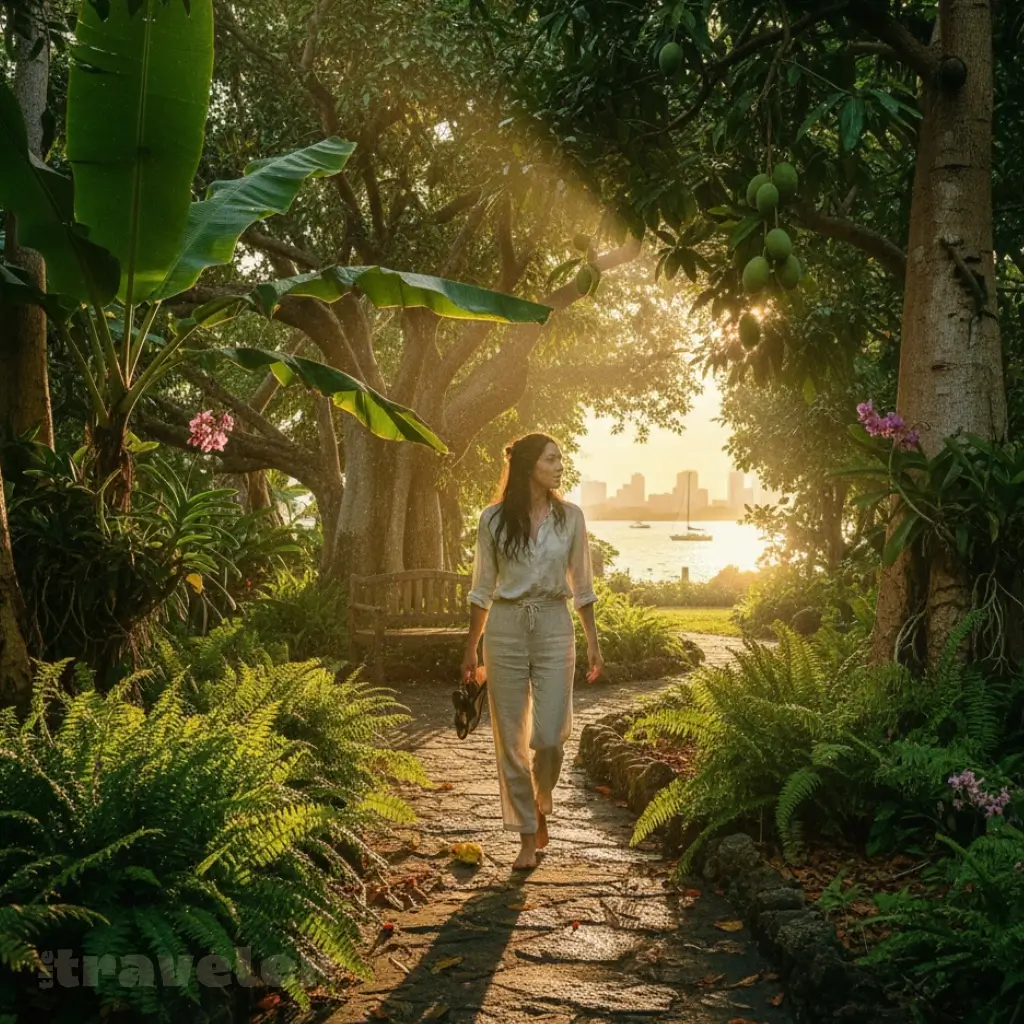
My quest for different perspectives brought me to The Kampong, a botanical garden in Coconut Grove filled with exotic fruit trees and the legacy of plant explorer David Fairchild. Few realize that it also offers one of Miami’s most enchanting sunset settings.
The gardens require advance reservations, so the grounds are never overcrowded and the atmosphere remains serene. As the day faded, soft light filtered through the canopy and stretched toward Biscayne Bay. I wandered along shaded paths lined with sapodilla, mango and baobab trees, listening to parrots chatter overhead. When I reached a clearing overlooking the bay, the sun was hovering just above the horizon.
The scene felt like a tropical painting come to life. The sky glowed amber and the water shimmered. In the distance, the downtown skyline was visible but softened by humidity, appearing almost dreamlike. I sat on a bench and thought about how few people were sharing this moment with me. This exclusivity made the experience feel rare and personal.
Watching the sun sink beyond the horizon from this quiet corner of Coconut Grove reminded me that Miami is more than beaches and nightlife; it is also a city of gardens, of botanical exploration, of history. As the last light faded, I stayed a while longer, breathing in the earthy scent of mulch and blossoms, savoring the feeling of being hidden in plain sight.
Bill Baggs Cape Florida
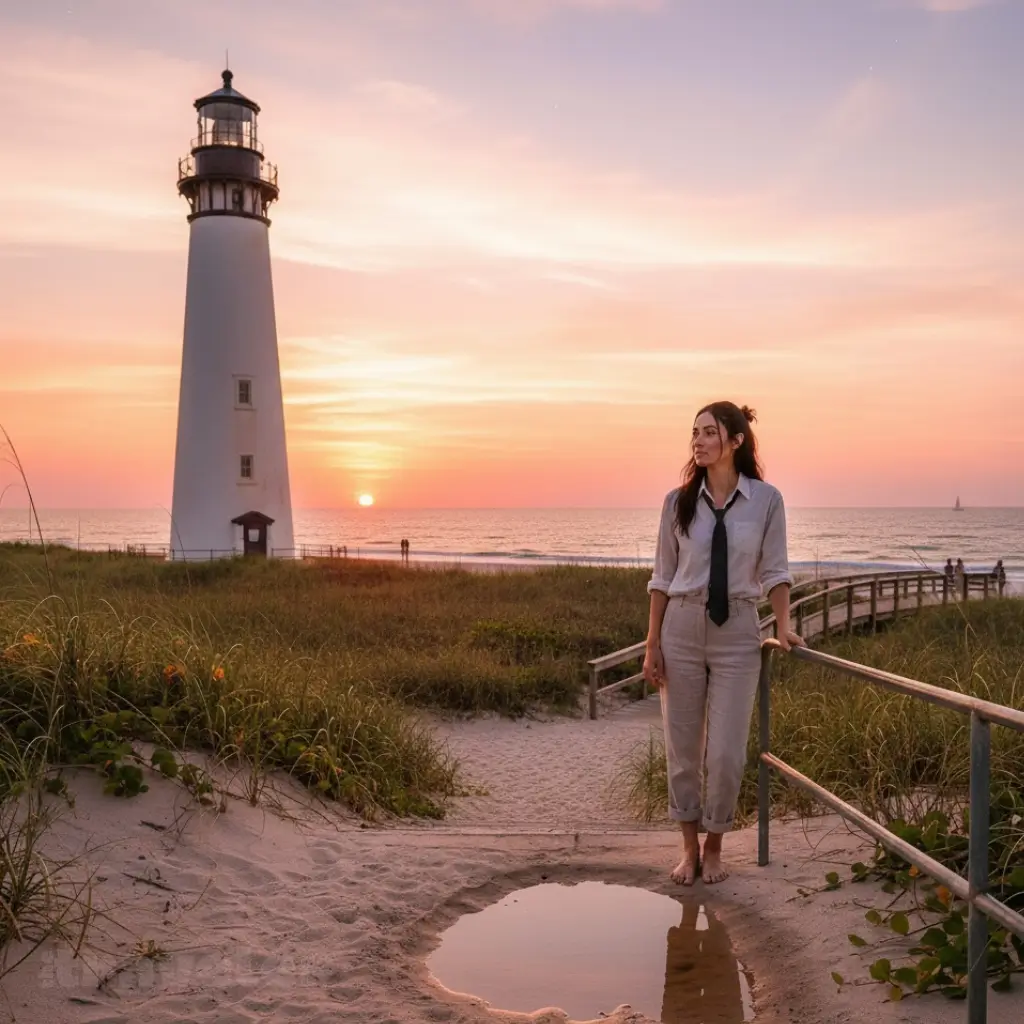
No exploration of Miami sunsets would be complete without visiting Bill Baggs Cape Florida State Park at the southern tip of Key Biscayne. The park’s centerpiece is the historic Cape Florida Lighthouse, built in the 1820s, which stands like a sentinel at the edge of land. Arriving here in the late afternoon, I walked along a trail framed by sea grapes and dune grasses until the lighthouse came into view. Its white tower contrasted sharply with the deepening blue of the sky.
Families were picnicking on the dunes, cyclists rolled past, and children built sandcastles. Yet there was a calmness to the scene. As the sun dipped behind the lighthouse, the sky was painted with warm hues and waves caught the shifting colors. It is one of the few places in Miami where you can watch the sun sink directly into the ocean. Miles of sandy shoreline offered ample space for everyone to settle in , ensuring the moment remained unhurried.
I climbed partway up the lighthouse steps, feeling the structure’s cool brick against my palm. Looking out from the gallery, I saw the beach, the blue expanse of the Atlantic and the Miami skyline far to the north. The water below glowed gold, then crimson, then purple. When the sun finally slipped below the horizon, a collective sigh rose from the beach.
Lights flickered on in the lighthouse keeper’s cottage. The blend of history and scenery at Bill Baggs delivered both aesthetic beauty and a sense of continuity. In that fading light, I reflected on how many sunsets this lighthouse had witnessed and how many lives it had guided. Watching the sky ignite from this quiet corner of Key Biscayne reminded me that sometimes the most extraordinary experiences come from understated places.
Sunset Harbour Marina

Back in South Beach, I visited Sunset Harbour Marina. Known for trendy restaurants and fitness studios, the marina transforms at dusk into one of the city’s most stylish places to catch a sunset. Yachts and sailboats reflect the glow as the sky burns orange and purple. I walked along the docks, admiring the sleek boats bobbing gently and the reflections dancing on the water. The boho‑chic restaurants that line the marina softened their lighting, and the atmosphere turned almost languorous.
The sun dipped low, aligning perfectly with the channel between the Venetian Islands. Colors spilled across the water like spilled paint. The marina offered a polished coastal vibe, capturing Miami’s glossy yet relaxed essence.
It was here, surrounded by modernity but looking out at a natural light show, that I realized how Miami’s sunsets capture the city’s dual nature. Miami is both sleek and raw, glamorous and wild. It has a reputation for parties and nightlife, yet some of its most enchanting moments arrive with the day’s quiet ending.
As the sun dipped below the horizon, the city transformed; softer hues, glowing skies and reflections made even locals pause in awe. In that transformation I felt my own perception of the city change. I had come for the energy, but I stayed for the quiet magic that reveals itself when the clubs are still, when the only music is waves and the distant hum of traffic.
Science and Feeling
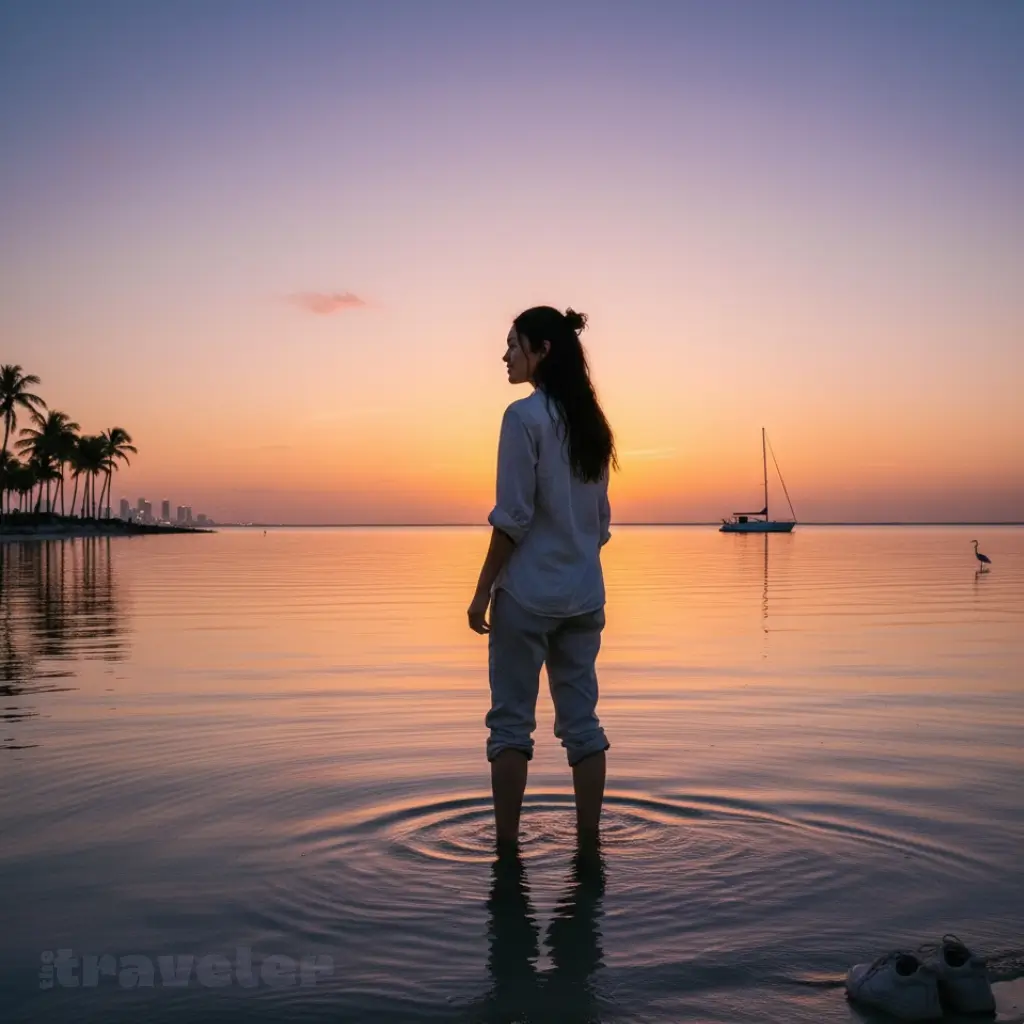
Watching a sunset is both a sensory and intellectual experience. Science explains why the sky turns red, orange and pink at sunset. When the sun is low, its light travels through a greater thickness of the atmosphere, and the shorter blue wavelengths scatter out while longer red and orange wavelengths pass through. Clouds reflect these longer wavelengths, intensifying the colors. Moisture and particles like dust further scatter the light, bending and bouncing rays in dramatic ways.
Clear skies can lead to bright colors; scattered clouds add depth and dimension, and humidity makes the colors vivid. Knowing these facts enriches, rather than diminishes, the emotional impact. It means that when I watch a Miami sunset, I am witnessing a complex interaction of atmosphere, light and weather. The beauty is not arbitrary; it is the universe functioning exactly as it should.
And yet the feeling of watching the sun descend is impossible to quantify. The colors evoke emotions that range from nostalgia to hope, melancholy to joy. There is something about those minutes when the day ends that invites introspection. Across cultures, sunsets symbolize renewal, gratitude, reflection and hope. In Miami, where life often moves at a frenetic pace, the sunset serves as a daily pause – a reminder to breathe. The ritual of gathering by the water, of turning toward the horizon, fosters a sense of community among strangers. Each person shares the same light, the same sky; their stories may differ, but for a few moments they are united by color.
A Skyline Aglow

I remember one evening when I watched the sun set from a high‑rise balcony in Brickell. From that height the city seemed to float, an island in the sea. The towers along Biscayne Bay reflected the sky’s hues back into the water. There is a surreal moment when the golden light reaches the glass façades, and the entire skyline glows as if lit from within. The lights of the city begin to twinkle as day turns to night , creating a dazzling contrast to the natural beauty of the sunset.
The Miami River wound its way through the city like a ribbon of mercury. I felt a chill even though the temperature remained warm. Maybe it was the breeze funneling between buildings, or maybe it was a shiver of realization: I was falling in love with this city in a way I did not expect.
From above, the patterns of Miami became clear. The grid of streets, the curves of the causeways, the green of islands dotting the bay. Far out I could see the open Atlantic. Up close I saw people on their balconies, raising glasses to toast the twilight. The hum of traffic softened. Sirens grew distant. When the last orange smear disappeared and the sky deepened to navy, I understood how intimately Miami is tied to the water.
The reflection of sunset on the water and on the city’s high‑rise buildings creates one of the most breathtaking sights you’ll ever see. That interplay between land and sea, light and structure, is what makes Miami feel alive.
The Unexpected Stillness of a City

Perhaps the most surprising part of my sunset journey was the sense of stillness I found in a city famous for motion. I came to Miami expecting constant stimulation – music, dancing, energy. And yes, the city offers that. But in the evenings I discovered quiet corners where waves whisper, where sailboats drift, where the sky’s colors move slowly enough for you to feel time stretching. In secret spots tucked away from the bustle, you can hear waves, watch sailboats drift across the bay and take in the sky’s changing colors as if they were painted just for you.
In these places, stillness competes with splendor. You settle into the sand with a picnic, stroll along shaded trails or simply sit back and soak in the atmosphere. It is in these moments that Miami reveals its softer side, one that invites reflection rather than performance.
I remember one evening at a hidden spot near the Venetian Islands, away from the crowds. A group of friends chatted quietly on a blanket; an old man played a guitar softly; a dog chased birds along the shoreline. The sky changed from fiery orange to gentle lavender, and the city’s neon lights flickered to life behind us. The juxtaposition was striking: the natural world performing a centuries‑old dance, and the human world flickering like its own constellation.
In that moment I felt my anxieties dissolve. I realized that what drew me in was not the thrill of nightlife but the invitation to slow down. Miami taught me that sometimes you find love in the pauses between songs, in the quiet between waves.
Falling in Love Through Light
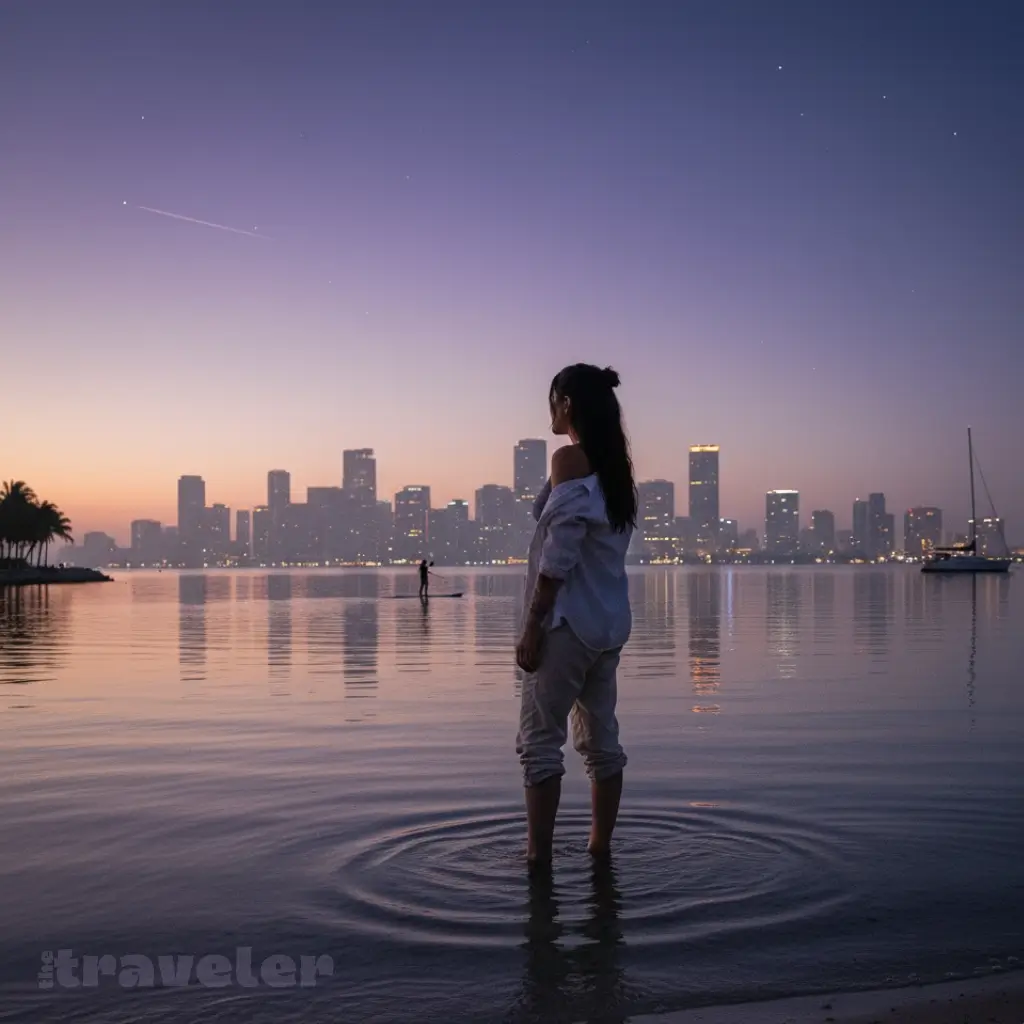
Why did a sunset capture Miami’s essence for me? Part of it is the interplay of colors and climate. Miami’s tropical conditions scatter sunlight and produce brilliant hues that seem to last longer. The humidity and ocean air turn the sky into a canvas of orange, pink and purple. The reflection of the sunset on the ocean intensifies these colors. Part of it is the way the city’s skyline interacts with that natural palette.
As the sky transitions from golden to deep purple, the cityscape begins to glow and the lights of the city start to twinkle. This contrast between nature and human creation is inherently Miami; the city thrives on juxtaposition. Another part is the abundance of places to watch the show – from tranquil atoll lagoons and secret beaches to bustling piers and marinas. Each offers a different perspective, and together they form a mosaic of experiences.
Yet the true reason is more personal. Watching those sunsets allowed me to be present in a way I rarely am. In Miami, I learned to pause and pay attention. I felt the air cool against my skin, tasted salt on my lips, smelled the mix of sea spray and tropical flowers, heard waves and distant laughter, and saw colors I had only ever imagined.
In those sensations I found a connection to the place. The sunsets made me feel part of something larger – part of an atmosphere and a community and a moment. They reminded me that beauty can exist simultaneously with chaos, that cities are not just noise but also quiet. They gave me a ritual that grounded me.
Looking back, falling in love with Miami through a sunset seems inevitable. The city’s magic reveals itself when day and night meet, when neon and twilight share the sky. Miami’s sunsets are unique because of their brilliant colors, their reflections on both water and glass, and the way they invite stillness amidst motion.
They taught me that what makes a place special is not only its attractions but the feelings it stirs. In a world that often demands we move quickly and look forward, Miami’s sunsets taught me to slow down and look west.
FAQ
Why are Miami sunsets so colorful?
Miami’s humidity and ocean air scatter sunlight, producing brilliant hues of orange, pink, and purple.
Where are the best places to watch a sunset in Miami?
Sunset Harbour, South Pointe Park, Matheson Hammock Park, and Bill Baggs Cape Florida offer the best views.
What time does the sun usually set in Miami?
Depending on the season, sunset occurs between 5:30 PM and 8:15 PM. Arrive early for the golden-hour glow.
Is it safe to watch sunsets alone in Miami?
Yes, most bayside and beachfront areas are well-patrolled and filled with other sunset watchers.
Why do sunsets in Miami feel so special?
Because they combine science, atmosphere, and emotion — blending ocean reflection, humidity, and human connection.
